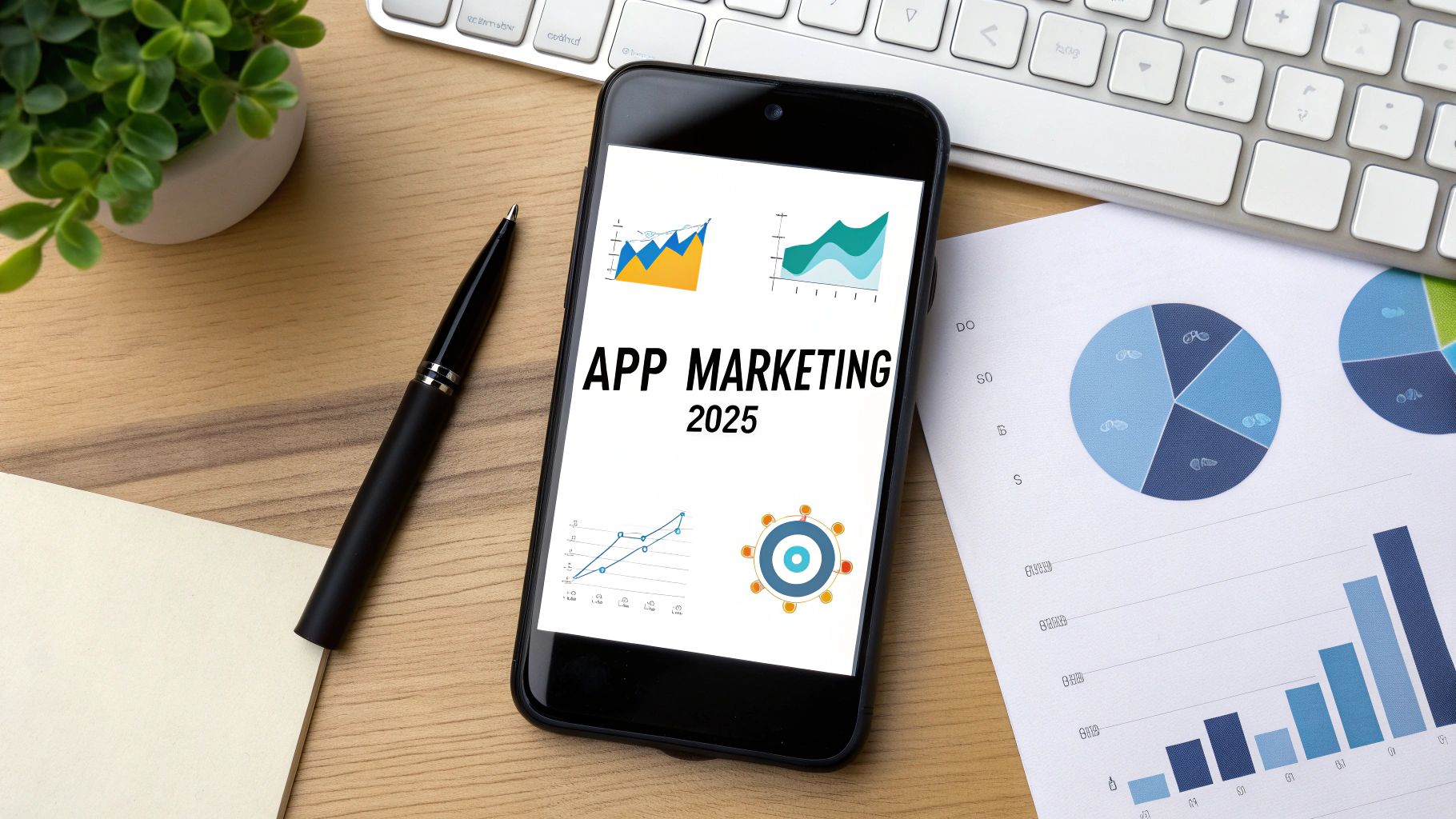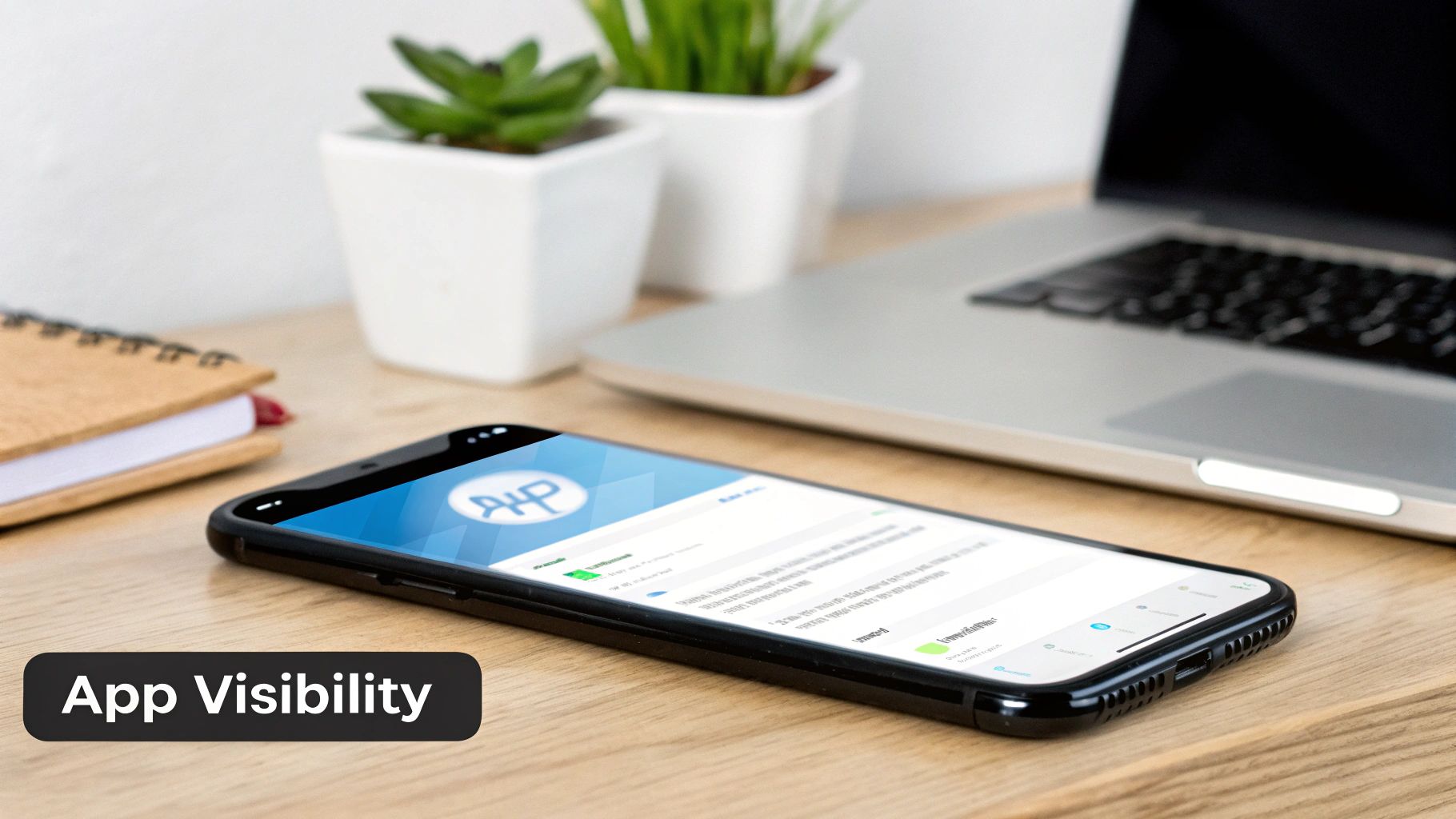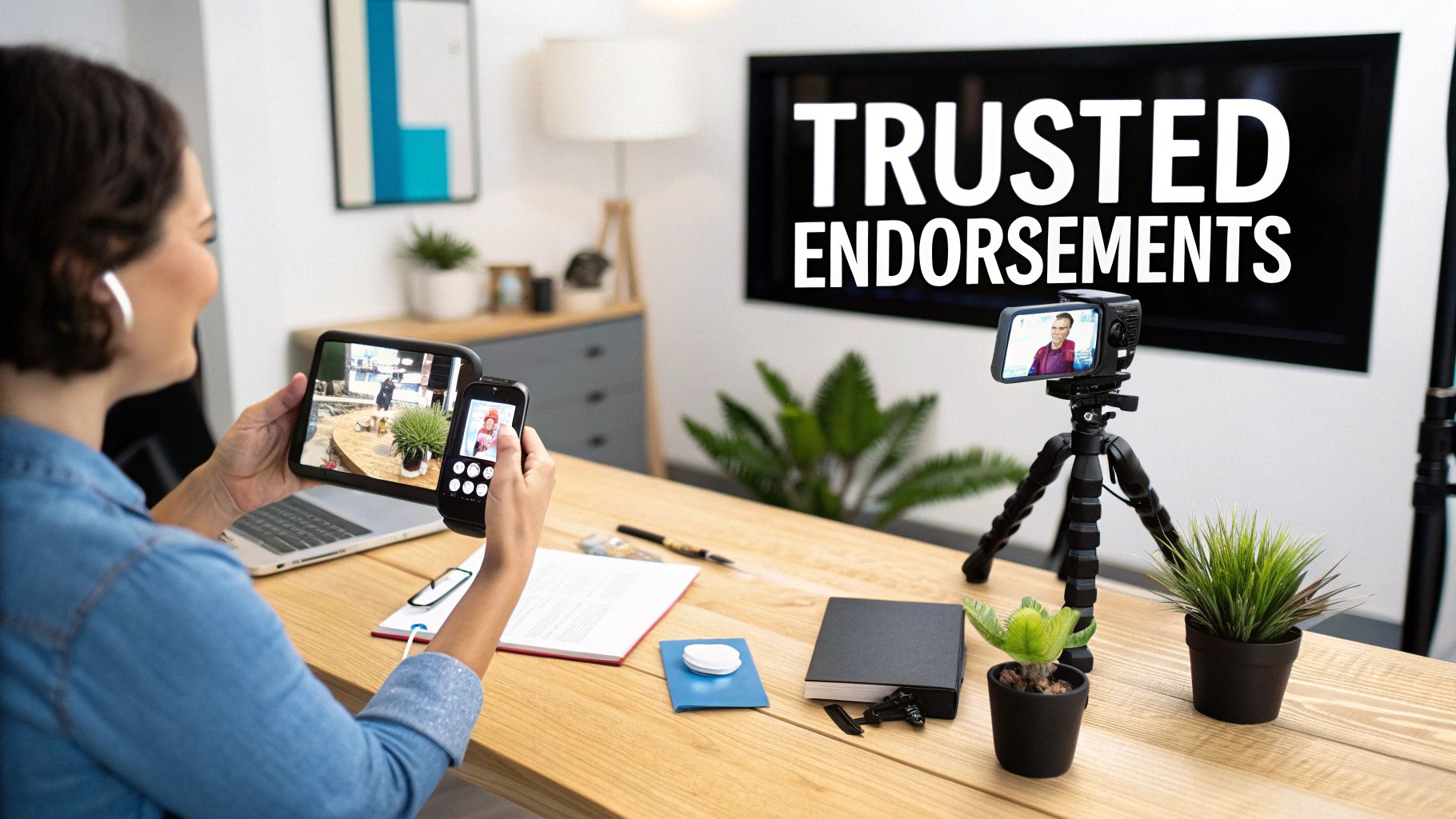
10 Essential Mobile App Marketing Strategies for 2025
Discover 10 essential mobile app marketing strategies for 2025. Drive downloads, engagement, and retention with our expert guide to ASO, UA, and more.
Launching an app is just the first step; true success lies in what comes next. In a marketplace with millions of competitors, getting noticed and staying relevant requires more than just a great product. It demands a sophisticated, multi-faceted approach to marketing that drives consistent, high-quality user acquisition and fosters long-term loyalty. A successful launch is not an event, but the beginning of a sustained effort.
This guide moves beyond surface-level tips to provide a comprehensive roundup of 10 essential mobile app marketing strategies that address the entire user lifecycle. We will cover everything from initial discovery and acquisition to long-term engagement and retention. Forget generic advice; we are breaking down each strategy into actionable steps, providing fresh perspectives and real-world examples to help you build a robust marketing engine.
Here, you will find a blueprint for sustainable growth in 2025 and beyond. Whether you're a startup founder or a seasoned marketer, these proven tactics will equip you to navigate the complexities of app promotion. Prepare to learn how to master App Store Optimization, leverage influencer marketing, execute effective paid campaigns, and build a community that turns your app into a category leader.
1. App Store Optimization (ASO): Your Digital Storefront
App Store Optimization (ASO) is the cornerstone of effective mobile app marketing strategies. It is the continuous process of improving an app's visibility within app stores like Apple's App Store and Google Play. By optimizing elements such as keywords, titles, and visuals, you increase the likelihood of your app appearing in relevant search results, directly driving organic, high-intent downloads.

Think of ASO as Search Engine Optimization (SEO) for your app. A well-executed ASO strategy ensures that when users search for a solution your app provides, you are front and center. This is a foundational strategy because it capitalizes on user intent at its peak, significantly boosting your conversion rates from impression to install. For example, Headspace uses calming visuals and targets keywords like "meditation" and "sleep sounds" to attract users actively seeking mindfulness solutions.
Actionable ASO Tips
To implement ASO effectively, focus on these key areas:
- Keyword Research: Identify and target relevant, long-tail keywords with lower competition but high user intent. Use tools like Sensor Tower or data.ai to find these opportunities.
- Compelling Visuals: Your app icon must be distinct and memorable. Use all available screenshot and video preview slots to create a compelling visual narrative that showcases your app's core value proposition, much like Duolingo uses colorful screenshots to illustrate its learning journey.
- Metadata Optimization: Craft a clear, keyword-rich title and a persuasive description. Regularly update your metadata based on performance data and keyword trends.
- Ratings and Reviews: Actively encourage satisfied users to leave positive reviews, as they heavily influence both rankings and user trust.
2. Influencer Marketing: Leveraging Authentic Voices
Influencer marketing has become a powerhouse in the world of mobile app marketing strategies. It involves collaborating with content creators and personalities on platforms like YouTube, TikTok, and Instagram to promote your app to their dedicated followers. This approach leverages the trust and authenticity influencers have cultivated, turning their recommendations into powerful drivers for app downloads and engagement.

Unlike traditional advertising, influencer partnerships feel more like a trusted recommendation from a friend. When an influencer genuinely integrates an app into their content, it resonates deeply with their audience, creating brand awareness and driving action. For example, gaming giant Raid: Shadow Legends achieved massive scale by partnering with hundreds of YouTubers and Twitch streamers, while the Calm app works with wellness experts to reach users actively seeking mindfulness solutions.
Actionable Influencer Marketing Tips
To launch a successful influencer campaign for your app, consider these key steps:
- Strategic Vetting: Choose influencers whose audience perfectly aligns with your target demographic. Vet them thoroughly for brand safety, authenticity, and past performance to ensure a good fit.
- Embrace Micro-Influencers: Don't just focus on big names. Micro-influencers often have higher engagement rates and are more cost-effective, providing excellent ROI for niche apps.
- Creative Freedom: Provide clear brand guidelines but allow influencers the creative freedom to present your app in their own unique voice. This fosters authenticity and resonates better with their audience.
- Trackable Conversions: Equip each influencer with unique promo codes or trackable download links. This allows you to accurately measure the campaign's success and identify your top-performing partners.
3. Social Media Marketing: Building Communities to Drive Downloads
Social media marketing for mobile apps involves creating and sharing targeted content across various platforms to build brand awareness, engage with potential users, and directly drive app installs. This strategy goes beyond simple advertising; it’s about building a community, leveraging social proof, and creating a vibrant digital presence that supports user acquisition and long-term retention.

By meeting users where they spend their time, you can create a powerful, authentic connection that other mobile app marketing strategies might miss. For instance, Duolingo's viral success on TikTok wasn't just about ads; it was about creating witty, platform-native content that resonated with the audience and made the brand a cultural touchpoint. Similarly, the explosive popularity of Among Us was fueled by organic social sharing and memes on platforms like Twitter and Reddit, proving the power of community-driven marketing.
Actionable Social Media Tips
To implement a successful social media strategy, focus on these key actions:
- Platform-Specific Content: Tailor your content's format and tone to each platform. Use Instagram Stories for behind-the-scenes glimpses, TikTok for short, entertaining videos, and LinkedIn for professional insights about your app's industry impact.
- Create Shareable Value: Develop content that is inherently shareable, such as infographics, relatable memes, or videos that clearly demonstrate your app's core value. This encourages organic reach and user-generated promotion.
- Engage and Build Community: Actively respond to comments, run contests, and feature user-generated content. Building an engaged community turns passive followers into passionate brand advocates.
- Leverage Social Proof: Showcase user testimonials, positive reviews, and success stories in your posts. This builds trust and provides compelling evidence for why someone should download your app. For those looking to streamline their efforts, you can learn more about how to automate social media posting.
4. Paid User Acquisition (UA) Campaigns
Paid User Acquisition (UA) is a proactive mobile app marketing strategy where you invest in advertising to drive targeted, high-quality downloads. Unlike organic methods, paid UA allows for precise audience targeting, rapid scaling, and measurable results, giving you direct control over your growth trajectory. By running campaigns on platforms like Facebook, Google, or Apple Search Ads, you can place your app directly in front of users most likely to install and engage with it.

This data-driven approach is fundamental for accelerating growth beyond the limits of organic reach. It enables you to compete in crowded markets and quickly build an initial user base. For example, gaming giants like King Digital Entertainment and Supercell used massive, strategic UA campaigns for Candy Crush Saga and Clash of Clans, respectively, to dominate the app charts and achieve global scale. This strategy is essential for achieving predictable growth and a positive return on ad spend (ROAS).
Actionable Paid UA Tips
To maximize your return from paid campaigns, implement these best practices:
- Start Small and Scale: Begin with modest test budgets on platforms like Google App Campaigns or Apple Search Ads. Identify winning creatives and targeting segments before scaling your investment.
- Focus on User Quality: Prioritize metrics beyond just the install volume. Track post-install events like registrations, purchases, or level completions to optimize for high-value users, not just downloads.
- Test Creatives Relentlessly: Continuously A/B test different ad formats, visuals, copy, and calls-to-action to find what resonates best with your target audience.
- Leverage Lookalike Audiences: Once you have a core group of valuable users, create lookalike audiences on platforms like Facebook to find new users with similar characteristics, dramatically improving campaign efficiency.
5. Content Marketing: Building Authority and Driving Downloads
Content marketing is a strategic approach focused on creating and distributing valuable, relevant, and consistent content to attract and retain a target audience. For mobile apps, this means moving beyond direct advertising to educate potential users, build brand authority, and demonstrate your app's value, ultimately guiding users toward installation and engagement. It is one of the most effective long-term mobile app marketing strategies for sustainable growth.
Think of content as the bridge connecting a user's problem to your app's solution. A well-executed content strategy establishes your brand as a trusted resource, attracting users organically through search engines and social sharing. For instance, the personal finance app Mint runs a successful blog offering money-saving tips and financial advice. This content attracts users searching for financial guidance, naturally positioning the Mint app as the ideal tool to implement that advice.
Actionable Content Marketing Tips
To leverage content marketing for your app, focus on these key areas:
- Problem-Solving Content: Create blog posts, videos, or guides that directly address the pain points of your target audience. If you have a fitness app, write about "10-minute home workouts" or "meal prep for beginners."
- SEO Optimization: Optimize all content for search engines using relevant keywords your audience is searching for. This ensures your valuable content is discoverable.
- Format Repurposing: Turn a popular blog post into a short video for social media, an infographic, or a podcast episode. This maximizes your reach without creating entirely new content from scratch.
- Clear Calls-to-Action (CTAs): Every piece of content should include a clear, compelling CTA that encourages users to download your app to solve their problems more effectively. If you're looking for deeper insights, you can find a comprehensive guide on startup content marketing here on viewprinter.tech.
6. Referral and Viral Marketing: Power Through People
Referral and viral marketing transforms your existing users into a powerful acquisition channel. This strategy encourages users to promote your app to their networks, often through incentives, word-of-mouth, and shareable in-app content. By creating compelling reasons for users to share, you can spark organic, exponential growth that traditional advertising struggles to match.
This is one of the most cost-effective mobile app marketing strategies because it leverages your happiest customers as brand advocates. Think of Dropbox's legendary program, which offered free storage for both the referrer and the new user, leading to a 3900% growth in 15 months. Similarly, TikTok’s entire ecosystem is built on inherently viral, shareable content. Beyond direct referrals, incorporating powerful viral marketing strategies can significantly accelerate your app's user acquisition by tapping into network effects.
Actionable Referral & Viral Tips
To build a successful growth loop, focus on these key actions:
- Simplify Sharing: Make the referral process frictionless. A user should be able to share with just one or two taps, integrating directly with their primary messaging and social apps.
- Offer Dual-Sided Rewards: Incentivize both the referrer and the referee. This creates a mutually beneficial exchange, like Uber offering ride credits to both parties, which increases the likelihood of conversion.
- Create Shareable Moments: Build virality directly into the app experience. This could be a high score, a completed milestone, or a piece of user-generated content that is naturally shareable. Discover how to create truly viral content.
- Track and Optimize: Implement robust tracking to understand your referral funnel. Monitor key metrics like share rate, click-through rate, and conversion rate to identify and fix points of friction.
7. Email Marketing: Building a Direct Line to Your Users
Email marketing remains a powerhouse among mobile app marketing strategies, providing a direct and personal communication channel to your users. It involves sending targeted email campaigns to onboard new users, share valuable content, re-engage inactive segments, and promote key app features. By building an email list, you create an owned asset, reducing reliance on paid channels and algorithms.
Unlike transient social media posts, emails land directly in a user's personal space, allowing for deeper engagement. A well-crafted email strategy nurtures the user relationship from pre-download interest to long-term loyalty. For instance, Spotify uses personalized "Weekly Discover" emails to drive app usage, while Airbnb sends location-based travel inspiration that encourages users to open the app and start planning their next trip.
Actionable Email Marketing Tips
To leverage email effectively for your app, focus on these critical actions:
- Segment Your Audience: Group users based on behavior, such as new sign-ups, power users, or those at risk of churning. Send tailored messages to each segment to maximize relevance and impact.
- Provide Genuine Value: Go beyond promotions. Share useful tips, success stories, or exclusive content that helps users get more out of your app. Duolingo's streak reminders are a perfect example of value-driven engagement.
- Craft Compelling CTAs: Every email should have a clear goal. Use strong, action-oriented calls-to-action (CTAs) with deep links that take users directly to a specific screen within your app.
- Optimize for Mobile: Ensure your emails are fully responsive and look great on mobile devices. Use concise subject lines, scannable text, and large, tappable buttons.
8. PR and Media Outreach
PR and media outreach is a powerful strategy for building brand credibility and driving mass awareness. This approach involves securing earned media coverage from journalists, bloggers, and publications, effectively gaining a third-party endorsement for your app. Unlike paid advertising, positive press provides organic validation that can significantly influence public perception and user trust, making it a critical component of comprehensive mobile app marketing strategies.
Think of PR as storytelling on a grand scale. A well-placed article or feature can introduce your app to millions of potential users overnight. For example, Clubhouse’s initial explosion in popularity was fueled by exclusive coverage in major tech publications, creating an aura of exclusivity and must-have appeal. This kind of earned media coverage builds momentum that advertising alone cannot replicate, positioning your app as a noteworthy player in its category.
Actionable PR and Media Outreach Tips
To effectively manage your media outreach, focus on these key activities:
- Develop Newsworthy Angles: Don't just pitch your app; pitch a story. Frame your app around a current trend, a unique solution to a common problem, or compelling user data.
- Build Relationships Early: Connect with relevant journalists and influencers on social media or at industry events long before you need to pitch them. Provide value by sharing their work or offering insights.
- Create a Professional Media Kit: Prepare a readily accessible folder with high-resolution logos, screenshots, founder bios, a fact sheet, and your press release. This makes a journalist's job easier.
- Offer Exclusives: Give a key publication exclusive access to your launch, a new feature, or proprietary data. This can significantly increase your chances of securing in-depth coverage.
9. Partnership and Cross-Promotion
Partnership and cross-promotion is one of the most powerful mobile app marketing strategies for tapping into new, relevant audiences. This approach involves collaborating with complementary, non-competing brands or apps to market each other’s products. By leveraging the established trust and user base of a partner, you can acquire high-quality users at a fraction of the cost of traditional paid acquisition channels.
This strategy is effective because it creates a win-win scenario. Your partner gains exposure to your audience, you gain exposure to theirs, and users discover valuable, synergistic services. For instance, the well-known partnership between Spotify and Uber allows riders to control the music during their trip, enhancing the experience for both services' users and strengthening brand loyalty.
Actionable Partnership Tips
To execute a successful cross-promotion campaign, focus on creating mutual value:
- Identify Synergistic Partners: Seek out apps or brands whose audience demographics and interests align with yours but who are not direct competitors. A fitness app partnering with a healthy meal delivery service is a classic example.
- Define Clear Goals: Establish what success looks like from the start. Key metrics could include referral installs, in-app event completions from referred users, or an increase in brand mentions.
- Create Co-Branded Value: Develop integrated experiences or co-branded content that benefits both user bases. This could be anything from a special offer, a bundled subscription, or an in-app integration.
- Start Small and Test: Before committing to a large-scale collaboration, run a smaller pilot campaign. This allows you to test the partnership's effectiveness and work out any operational kinks with minimal risk.
10. Retention and Engagement Marketing
Retention and engagement marketing is a critical component of sustainable mobile app marketing strategies, focusing on keeping existing users active rather than solely acquiring new ones. It involves creating targeted, value-driven experiences that encourage users to return to your app consistently. Through personalized communications like push notifications and in-app messages, you can nurture the user journey, reduce churn, and significantly increase user lifetime value.
Acquiring a new user is far more expensive than retaining an existing one, making this strategy essential for long-term profitability. By understanding user behavior and delivering timely, relevant content, you transform casual users into loyal advocates. For instance, Duolingo's famous streak notifications and achievement systems gamify the learning process, creating a powerful incentive for daily engagement and turning language practice into a habit.
Actionable Retention Tips
To implement retention marketing effectively, focus on these key areas:
- Segment and Personalize: Group users based on their in-app behavior, engagement level, and lifecycle stage. Use this data to send personalized messages that resonate with their specific needs and interests.
- Proactive Intervention: Use analytics to identify users at risk of churning, such as those with declining session times. Intervene with targeted offers, feature tutorials, or surveys to re-engage them before they leave.
- Optimize Onboarding: Create a compelling and seamless onboarding experience that quickly demonstrates your app's core value. Use progressive disclosure to introduce features gradually, preventing new users from feeling overwhelmed.
- Test and Refine: Continuously test the timing, frequency, and content of your retention campaigns to find what works best. For a deeper dive into maximizing user value, consult an Expert Guide on Increasing Customer Lifetime Value.
Top 10 Mobile App Marketing Strategies Comparison
| Strategy | Implementation Complexity 🔄 | Resource Requirements ⚡ | Expected Outcomes 📊 | Ideal Use Cases 💡 | Key Advantages ⭐ | |-------------------------------|------------------------------------------|----------------------------------------------|-------------------------------------------------|------------------------------------------------|---------------------------------------------| | App Store Optimization (ASO) | Moderate - ongoing updates and A/B testing | Moderate - requires keyword research tools, design, analytics | Gradual organic growth and improved discoverability | Organic app growth, competitive app stores | Cost-effective user acquisition, sustainable long-term growth | | Influencer Marketing | High - managing relationships and content creation | High - influencer fees, content production | Increased brand awareness and user engagement | Launch phases, brand building, targeted demographics | Authentic endorsements, access to engaged audiences | | Social Media Marketing | Moderate to High - consistent content planning and community management | Moderate - content creation and paid ads budget | Broad reach with viral potential and engagement | Brand awareness, community building, diverse audiences | Wide demographic reach, real-time engagement | | Paid User Acquisition (UA) | High - requires expertise in ad platforms and optimization | High - significant ad spend and creative production | Rapid user growth and scalable acquisition | Fast scaling, competitive markets, measurable ROI | Precise targeting, quick measurable results | | Content Marketing | Moderate - requires continuous content creation and SEO | Moderate - content production, marketing team | Long-term brand authority and lead generation | Educating users, thought leadership, organic search | Builds trust, cost-effective over time | | Referral and Viral Marketing | Moderate to High - designing viral mechanics, tracking | Moderate - rewards, development of sharing features | Exponential organic growth and high trust users | Apps with social features, community growth | Lower CAC, strong community effects | | Email Marketing | Moderate - campaign automation and segmentation setup | Moderate - email platform and content creation | High ROI, user retention and engagement | Retention, onboarding, re-engagement | Personalized, scalable direct communication | | PR and Media Outreach | High - relationship building and pitching effort | Low to Moderate - PR tools, media kit creation | Earned media coverage and enhanced credibility | Brand authority, new product launches | High credibility, cost-effective publicity | | Partnership and Cross-Promotion | Moderate - negotiation and joint campaign management | Moderate - coordination with partners | Access to new audiences and shared resources | Complementary brands, co-marketing opportunities | Cost-effective growth, brand association | | Retention and Engagement Marketing | High - requires segmentation, personalization, and frequent campaigns | Moderate - automation tools, content creation | Increased user LTV, reduced churn, brand loyalty | Mature apps focusing on retention | Higher ROI than acquisition, builds advocacy |
Integrating Your Strategies for Maximum Impact
Navigating the competitive landscape of the app stores requires more than just a great product; it demands a sophisticated and dynamic marketing approach. The ten strategies detailed in this guide, from fundamental App Store Optimization to community-building social media campaigns, represent the essential pillars of a successful launch and sustained growth. However, their true power is unlocked not when they are executed in isolation, but when they are woven together into a cohesive, multi-channel engine.
The most effective mobile app marketing strategies are not a checklist to be completed but a living system to be managed. Your ASO efforts make your app discoverable, but it's your compelling content marketing and strong social proof that convince users to download. Paid user acquisition can provide an initial surge of traffic, while a well-timed email marketing sequence can convert those new users into loyal, high-value customers. Similarly, influencer marketing builds initial trust, which can be amplified exponentially through a strategic referral program. This interconnectedness is the key to creating a powerful growth loop where each strategy feeds and strengthens the others.
From Silos to Synergy: Your Actionable Roadmap
To move from theory to implementation, focus on integration and optimization. It's crucial to adopt a holistic approach that leverages both paid and organic channels. For instance, insights gained from your paid UA campaigns on platforms like Meta or Google can inform your ASO keyword strategy, while earned media from a successful PR push can be repurposed as powerful creative for your paid ads. For maximum impact, understanding the distinctions between earned media and paid media can help you optimize your resource allocation and build a balanced, resilient marketing mix.
Your immediate next steps should be to:
- Audit Your Current Efforts: Identify which of these ten strategies you are currently using and which are being neglected. Where are the biggest gaps?
- Prioritize Based on Your Stage: An app in its pre-launch phase will prioritize ASO and PR, while a mature app may focus more heavily on retention marketing and partnership cross-promotions.
- Establish a "Test and Learn" Culture: Don't be afraid to experiment. Allocate a small portion of your budget to test new channels or messages. Use analytics to measure everything, from click-through rates on your ads to open rates on your emails.
- Create a Unified User Journey: Map out how a user interacts with your brand across different touchpoints. Ensure the messaging is consistent, whether they discover you through an influencer's post, a targeted ad, or an App Store search.
Ultimately, mastering these mobile app marketing strategies is about building a sustainable ecosystem around your app. It’s about creating a flywheel that not only acquires users but engages, retains, and transforms them into advocates for your brand. This continuous cycle of improvement, powered by data and creativity, is what separates fleeting successes from enduring market leaders. The journey is ongoing, but with these frameworks in hand, you are well-equipped to build not just an app, but a thriving digital community.
Ready to bring your mobile app marketing visuals to life? ViewPrinter transforms your app screenshots and mockups into stunning, professional presentations for social media, ad creatives, and your app store listing. Elevate your brand with polished visuals that convert. Discover how at ViewPrinter today.